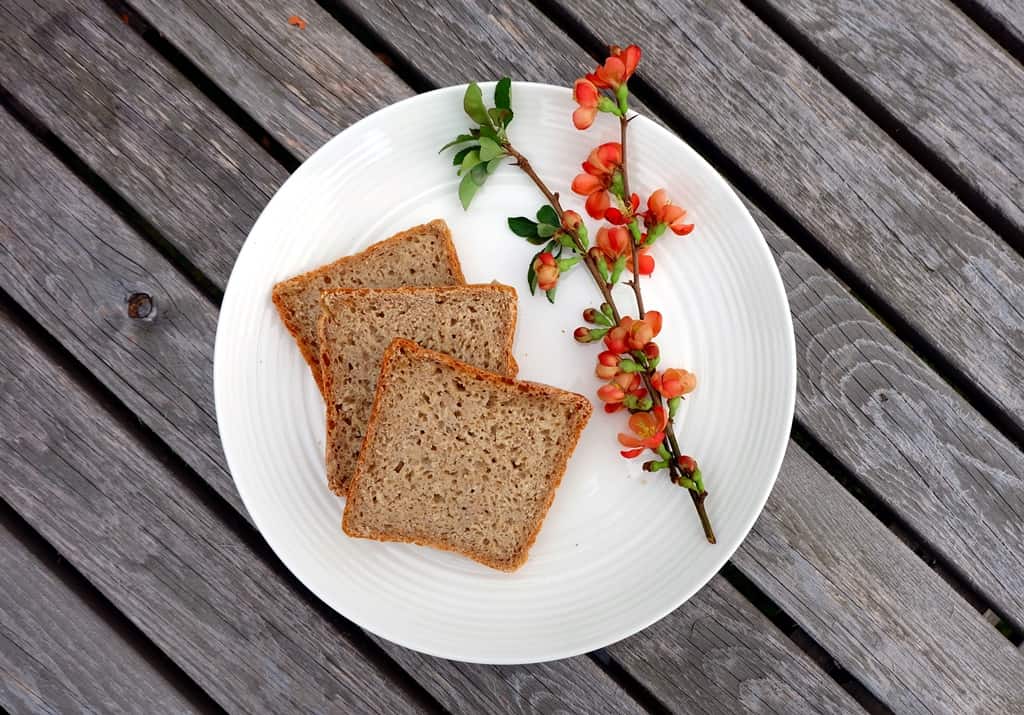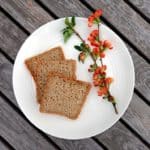The crunchy oatcakes I made earlier this year were the start of a new baking passion: baking with oats. Having experimented extensively over the past few months, baking with oats has become my new favourite thing. I put together this mini-guide as an introduction to this fabulous bread baking ingredient and you’ll also find my favourite oat bread recipes below.

Baking with oats: Oats properties
To start with, here is an introduction to the characteristics and baking properties of oats.
- The big gluten question
According to Coeliac UK, oats contain avenin, which is a protein similar to gluten. However, research has shown that most people with coeliac disease can safely eat avenin. Please note though that oats are often processed in the same places as wheat. Looking for oats which are not contaminated with wheat is therefore recommended for coeliacs. - Nutritional value
Comparing oats to wheat on nutritional terms, oats have a higher fat content (11% in oats versus 4% in whole-wheat). The amount of dietary fibre is pretty much the same but oats are also higher in calcium and iron. - The crumb effect
Due to natural high oil content, adding oats to dough softens the crumb and adds chewiness and moistness to the crumb. - Crust aesthetics
Oat flakes are also a good choice for bread toppings as they lend additional crunch, texture and a beautiful pattern to crusts. - Oat breads
When baking a leavened loaf with oatmeal, it’s best to combine it with strong wheat flour in order to produce a light loaf. That said, you can produce a delicious and unique loaf of oat bread using 100% oats, please see the recipe below.
Types of oats
Oats come in different shapes and forms. However, almost all variations have the same nutritional values based on the fact that the whole oat groat is used in the production process.
- Whole oat groat kernels: unbroken oat kernels (groats) that are separated from the inedible hulls and stalks after the harvest
- Pinhead oats (steel cut oats): groats that are cut into two or three pieces with a sharp metal blade
- Jumbo rolled oats: oat groats that have been softened with steam and then flattened between rollers
- Rolled oats: pinhead oat pieces that have been steamed and rolled into flakes
- Oatmeal: stone-ground oats of varying sizes (coarse, medium, fine)
- Oat flour: finer than oatmeal, made by grinding and sieving oats
- Oat bran: the outer layer of the oat kernel that is ground into a coarse meal
Oat bread recipes
What I love about all of the following oat bread recipes is the velvety texture of the crumb and added richness the oats provide. Try one or all of these and find fall in love with oat breads!
Homemade Whole Oat Bread Recipe
A light yet deliciously wholesome loaf of bread using whole oat groats and a small amount of fine oatmeal in combination with strong wheat flour.
Servings 0
Ingredients
Ingredients
- 70 g whole oat groats
- 400 g strong white bread flour
- 50 g fine oatmeal
- 7 g dried yeast
- 10 g salt
- 80 g grated apple no skin
- 215 g tepid water
- Rolled oats for dipping the loaf
Instructions
How to make whole oat bread
- Simmer the oat groats in plenty of water for 30 minutes
- Strain the groats under cold water and set aside
- In a bowl, combine the boiled oat groats, the white bread flour, fine oatmeal, the yeast and salt, the grated apple and the tepid water
- Form a dough and knead for 10 mins
- Place the dough back in bowl for 1 hour or so for its first rise
- Punch down the dough, then shape into a round loaf and place into a pre-floured round bread banneton
- Proof for several hours at room temperature until fully risen (the time this takes will depend on the temperature in your room)
- Preheat the oven to 220°C (if you are using a La Cloche baking dome, preheat the dome in the oven from cold)
- Bake at 220°C for 1o minutes, then at 200°C for another 50 minutes
- Cool on a wire rack
100% Oats Bread Recipe (No Wheat)
This recipe uses no wheat flour, only porridge oats mixed with crushed walnuts and combined with egg and yoghurt.
Servings 0
Ingredients
Ingredients
- 4 cups porridge oats
- 1/2 tsp bicarb of soda
- 1 cup walnuts crushed
- 1 egg beaten
- 1/2 cup milk
- 1/4 cup water
- 500 g natural yoghurt
Instructions
How to make 100% oat bread
- In a large bowl, combine the porridge oats with the bicarb of soda and mix
- Add the crushed walnuts and mix further
- In a separate bowl, combine the beaten egg, milk, water and natural yoghurt and whisk together
- Combine the dry with the wet ingredients
- Place in a baking tin
- Bake at 190°C for about an hour until the inside temperature is at 94°C
- Cool on a wire rack
Rustic Rolled Oats Bread
A large loaf of oat bread with a pillowy crumb texture and rustic crust. Great for breakfast and sandwiches.
Servings 0
Ingredients
Ingredients
Sourdough
- 9 g sourdough starter
- 85 g strong white bread flour
- 85 g water
Oat soaker
- 300 g rolled oats
- 600 g hot water
Main dough
- 475 g strong white bread flour
- 120 g dark rye flour
- 200 g water
- 21 g salt
- 7 g dried yeast
Instructions
How to make oat bread
- Prepare the sourdough by combining the sourdough ingredients in a bowl. Cover and keep at room temperature for 16 - 24 hours.
- At the same time, prepare the oat soaker by dry-roasting the rolled oats in a big frying pan. Transfer to a bowl, pour over the hot water, cover and also keep at room temperature for 16 - 24 hours.
- The day after, prepare the main dough by combining the sourdough, oat soaker, wheat flour, rye flour, water, salt and yeast in a large bowl.
- Knead for a good few minutes until you have a homogeneous and even dough.
- Place the dough back into the bowl, cover and rest at room temperature for about 2 hours.
- Give the dough another quick knead, then place in a large lightly-oiled Pullman baking tin (33 x 10 cm).
- Distribute the dough evenly.
- Cover with the Pullman tin lid and leave for several hours at room temperature to proof. In my relatively cold Edinburgh flat, it took a good seven hours for the bread to be fully proved. It should roughly double in size.
- Bake in a preheated oven, starting at 250°C for the first 10 minutes, then turning the temperature down to 200°C for another hour.
- Cool on a wire rack.
